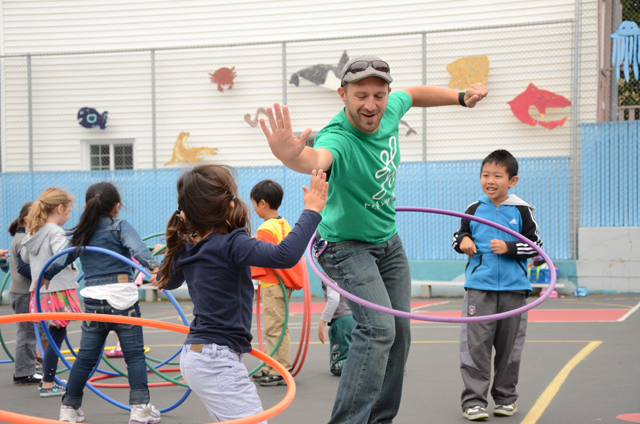“Rethinking How Students Succeed” called out the enormous power of non-cognitive skills to contribute to children’s development and learning in school. At Playworks we agree completely. What’s more, in our experience, we’ve found that there are untapped opportunities to develop those skills hiding in plain sight at schools across the country: through play and recess.
Recess and play have long represented a challenge for teachers during the school day. But we can transform these challenges into opportunities if we think about play as a tool for helping kids succeed. This sort of “downtime” is in fact an ideal environment in which to focus on social emotional learning and the competencies it emphasizes—self-awareness, self-management, social awareness, relationship skills, and responsible decision-making.
I started Playworks 19 years ago with the modest intention of helping some local principals. They had approached me because recess at their schools had grown untenable, and they wanted a way to regain control of that time and make the most of it for students in a fun and positive way. As I worked to build local programs, I quickly found that other schools also needed the same sort of help; demand was great, and it wasn’t limited to the Bay Area.
Today, Playworks has offices in 23 cities across the United States and provides both direct-service programming and training, reaching more than 500,000 students and more than 1,000 elementary schools annually. The direct-service programming involves placing a full-time coach—many of whom are AmeriCorps members—in low-income urban public elementary schools. Training, which is more widely available, ranges from one-day sessions to year-long partnerships with districts and schools. In every context, we start with the belief that play has the power to bring out the best in every child. By making inclusion, teamwork, leadership, and empathy a normal and expected part of play, grown-ups create a recess that students thrive in, empowering the students themselves to transform their schoolyards into social emotional learning environments.
A January, 2015 Journal of School Health article by Stanford researchers Rebecca London, Lisa Wetrich, Katie Stokes-Guinan, and Milbrey McLaughlin, entitled “Playing Fair: The Contribution of High-Functioning Recess to Overall School Climate in Low-Income Elementary Schools,” supported and confirmed our views. The article found that Playworks’ higher-functioning recess directly increased kids’ sense of safety and their use of pro-social tools in resolving conflicts. It also found that students’ experiences at recess quickly spilled over into the classroom.
Importantly, that article also noted the role of the adult “coach” during recess:
The coach played a big role in this change in connectedness. At recess and throughout the school day, students of all ages sought out the coach, who was often referred to as having “rock star” status. One principal told us that students talked to the coach about personal matters they would not discuss with other adults. We observed that the best coaches knew and used the names for every child, and played with them individually and in groups.
We believe that coaches achieve “rock star status” in part because in the context of play, they can emphasize their role as someone offering guidance and building relationships, rather than their role as a disciplinarian or a rule-setter. And we’ve seen that the “coach” need not be someone from outside the traditional teaching environment. When teachers use play as the vehicle for developing effective learners outside the classroom, it may lessen the pressures that both they and students can feel in the classroom, creating more openness and comfort with experimentation.
 Playworks Coach Bill models healthy play for the students during recess at a San Francisco elementary school. (Photo courtesy of Playworks)
Playworks Coach Bill models healthy play for the students during recess at a San Francisco elementary school. (Photo courtesy of Playworks)
While building teachers’ skills is obviously critical to ensuring a school climate that is conducive to learning, an emphasis on play and recess also represents an important opportunity for students to be the drivers of their own education. This space gives them choice and voice, and in doing so, empowers them to become leaders in the school community. Recess also represents a significant opportunity for students who haven’t had a history of success in the classroom to have the kinds of experiences that help them see the best in themselves. For these students, recess may even be the catalyst necessary for teachers to reconsider these students’ abilities.
Finally, while many social emotional learning programs have struggled with scale, recess is inherently scalable. Yes there have been some reports of the demise of recess, but as Twain famously quipped, “The reports of my death have been greatly exaggerated.” The CDC reports that 96.8 percent of elementary schools still have regularly scheduled recess in at least one grade, with an average allotted time of 30.2 minutes per day. Recess is one of the most effective ways to reach the biggest number of children.
Recess and playtimes often represent a challenge to teachers and administrators. So when educators see with their own eyes the rapid transformation in their students brought about by play, they are likely to experience a transformation of their own. The idea that every kid can thrive in school takes hold. The possibility and potential become very real. So while other programs may struggle to scale, a solution predicated on “fixing” recess stands a great chance of adoption, one that promotes social-emotional learning while eliminating the chaos at recess that detracts from the teaching and learning that our education professionals are so desperately working to deliver.
Note: The comments below pertain to the entire "Rethinking How Students Succeed" debate and not necessarily to this post.
Read the rest of the responses.

